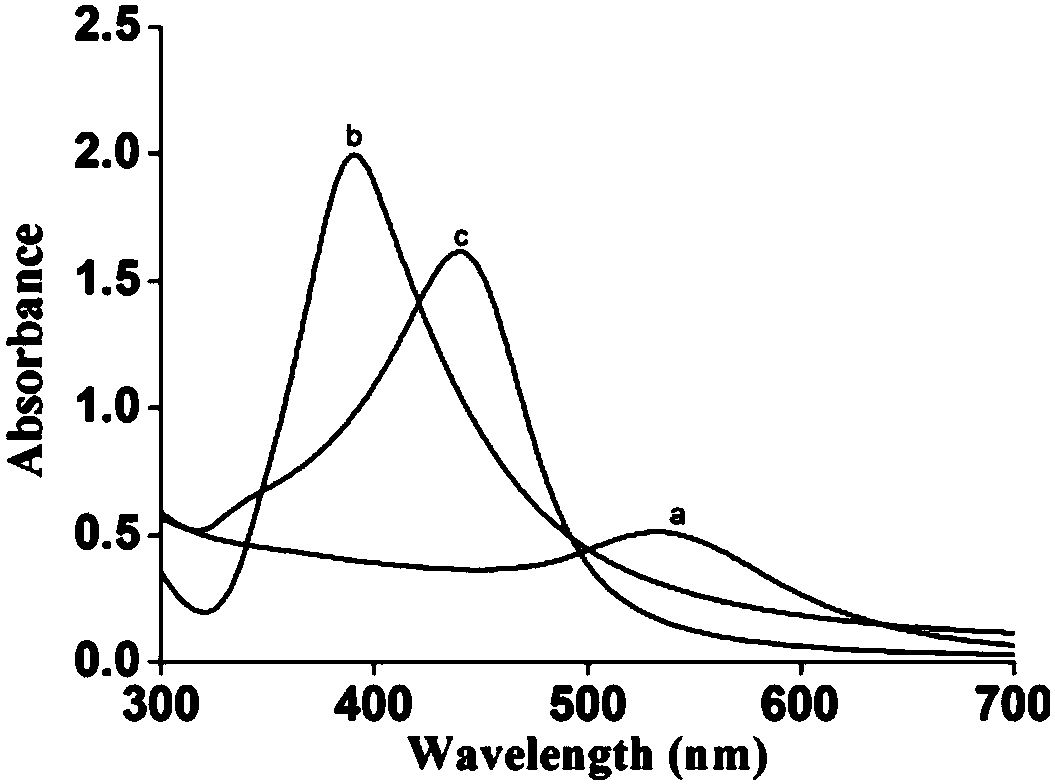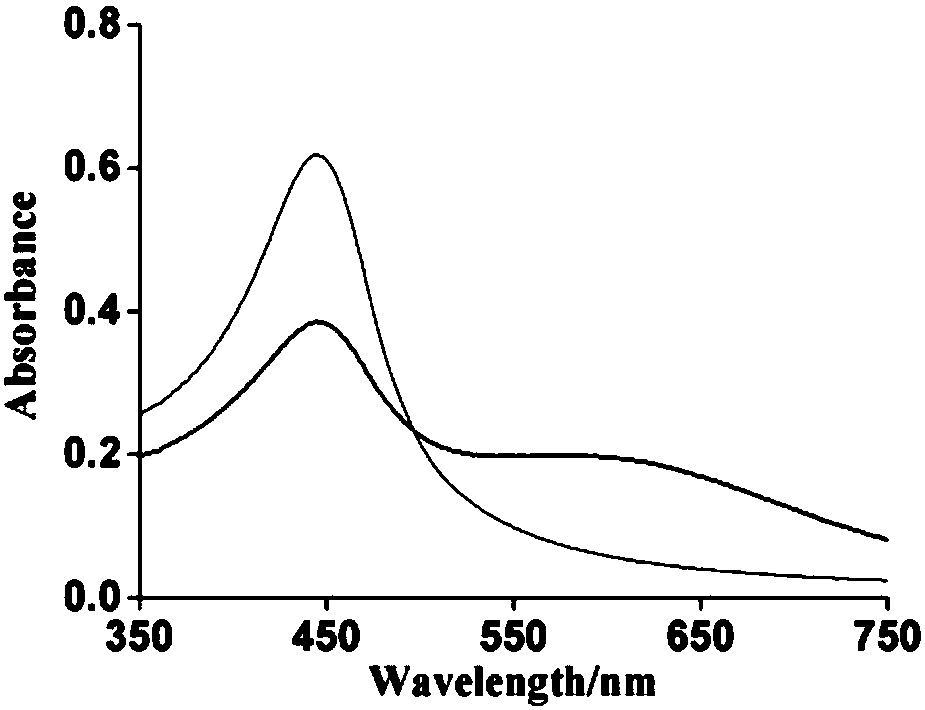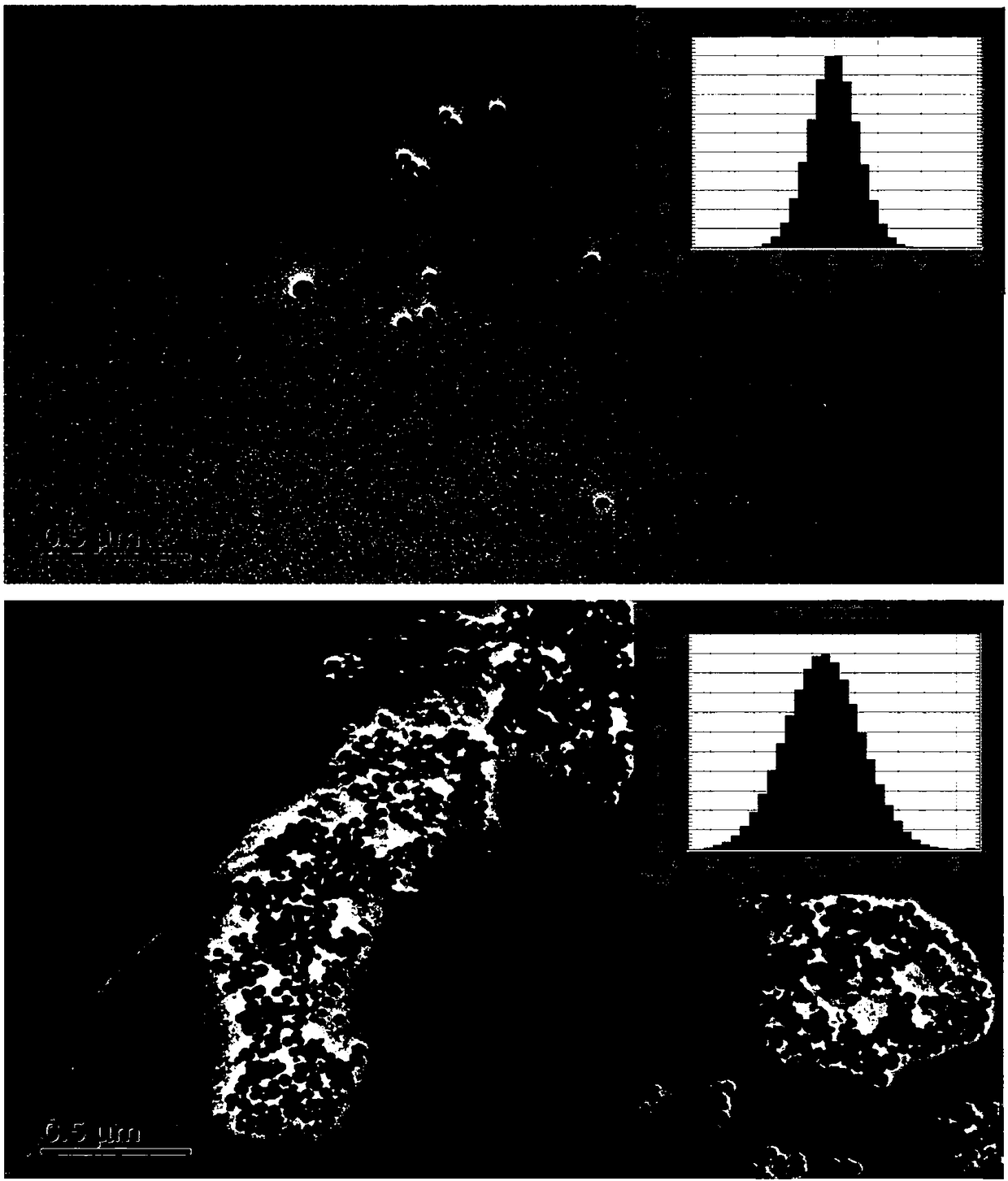Sulfanilic acid-modified gold-silver alloy nanoparticle colorimetric sensor and application thereof
A p-aminobenzenesulfonic acid and colorimetric sensor technology, applied in the field of analytical chemistry, can solve the problems of poor performance, inconvenient operation, and low accuracy of the ractopamine colorimetric sensor, and achieve good application prospects, simple operation, and short detection time short effect
- Summary
- Abstract
- Description
- Claims
- Application Information
AI Technical Summary
Problems solved by technology
Method used
Image
Examples
Embodiment 1
[0032] A colorimetric sensor based on gold-silver alloy nanoparticles modified by p-aminobenzenesulfonic acid was prepared by the following method: accurately pipette 48 μL of 1.0% (w / w) AgNO 3 solution and 47 μL of 1.0% (w / w) HAuCl 4 The solutions were added to flasks containing 15mL ultrapure water, condensed and refluxed for 5 minutes, then 250 μL of 0.4mM trisodium citrate solution was added at the same time, heated for another 2 minutes, then mixed immediately and continued to stir and heat for 15 minutes to obtain a clear and stable orange color The solution is the gold-silver alloy nanoparticle solution;
[0033] In above-mentioned newly synthesized gold-silver alloy solution, add 1mL1.0mM p-aminobenzenesulfonic acid solution and stir 2h at a constant speed, obtain the gold-silver nano-alloy solution modified by p-sulfanilic acid. The p-aminobenzenesulfonic acid concentration concentration in the gold-silver nano-alloy solution modified by p-aminobenzenesulfonic acid i...
Embodiment 2
[0077] A colorimetric sensor based on gold-silver alloy nanoparticles modified by p-aminobenzenesulfonic acid was prepared by the following method: take 48 μL of AgNO with a concentration of 1.0% (w / w) 3 solution and 47 μL of 1.0% (w / w) HAuCl 4 Each solution was added to 15mL ultrapure water, condensed and refluxed and heated for 5min, then 250μL of 0.4mM trisodium citrate solution was added to each solution, continued to heat for 2min, then mixed and continued to heat for 15min under stirring conditions, and then added 1mL of p-aminobenzenesulfonic acid solution with a concentration of 1mM was stirred at a constant speed for 2h to obtain a p-sulfanil-acid-modified gold-silver nano-alloy solution, which was the colorimetric sensor based on p-sulfanil-acid-modified gold-silver alloy nanoparticles. The gold-silver nano-alloy solution modified by sulfanilic acid contains 30 μM sulfanilic acid. The pH value of the gold-silver nano-alloy solution modified by p-aminobenzenesulfonic...
Embodiment 3
[0082] A colorimetric sensor based on gold-silver alloy nanoparticles modified by p-aminobenzenesulfonic acid was prepared by the following method: take 48 μL of AgNO with a concentration of 1.0% (w / w) 3 solution and 47 μL of 1.0% (w / w) HAuCl 4 Each solution was added to 15 mL of ultrapure water, condensed and refluxed for 5 min, and 250 μL of 0.4 mM trisodium citrate solution was added to it, and continued to heat for 2 min, then mixed and continued to heat for 15 min under stirring conditions, and then added 1 mL of The p-aminobenzenesulfonic acid solution with a concentration of 1 mM was stirred at a constant speed for 2 hours to obtain a p-aminobenzenesulfonic acid-modified gold-silver nano-alloy solution, which was the colorimetric sensor based on p-sulfanilic acid-modified gold-silver alloy nanoparticles. The gold-silver nano-alloy solution modified by sulfanilic acid contains 30 μM sulfanilic acid.
[0083] The application of the above-mentioned colorimetric sensor for...
PUM
| Property | Measurement | Unit |
|---|---|---|
| Particle size | aaaaa | aaaaa |
| Particle size | aaaaa | aaaaa |
Abstract
Description
Claims
Application Information
 Login to View More
Login to View More - R&D
- Intellectual Property
- Life Sciences
- Materials
- Tech Scout
- Unparalleled Data Quality
- Higher Quality Content
- 60% Fewer Hallucinations
Browse by: Latest US Patents, China's latest patents, Technical Efficacy Thesaurus, Application Domain, Technology Topic, Popular Technical Reports.
© 2025 PatSnap. All rights reserved.Legal|Privacy policy|Modern Slavery Act Transparency Statement|Sitemap|About US| Contact US: help@patsnap.com



